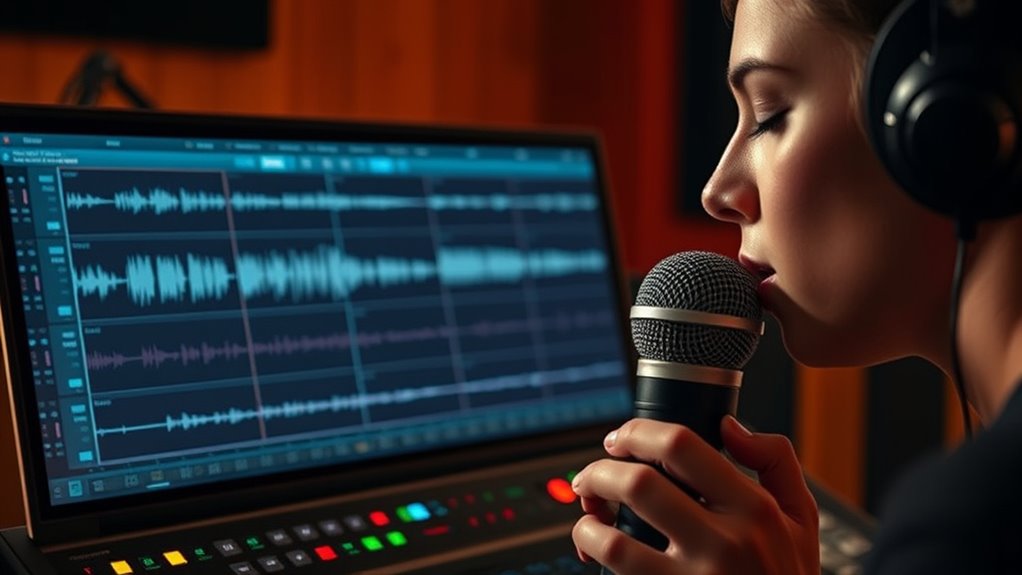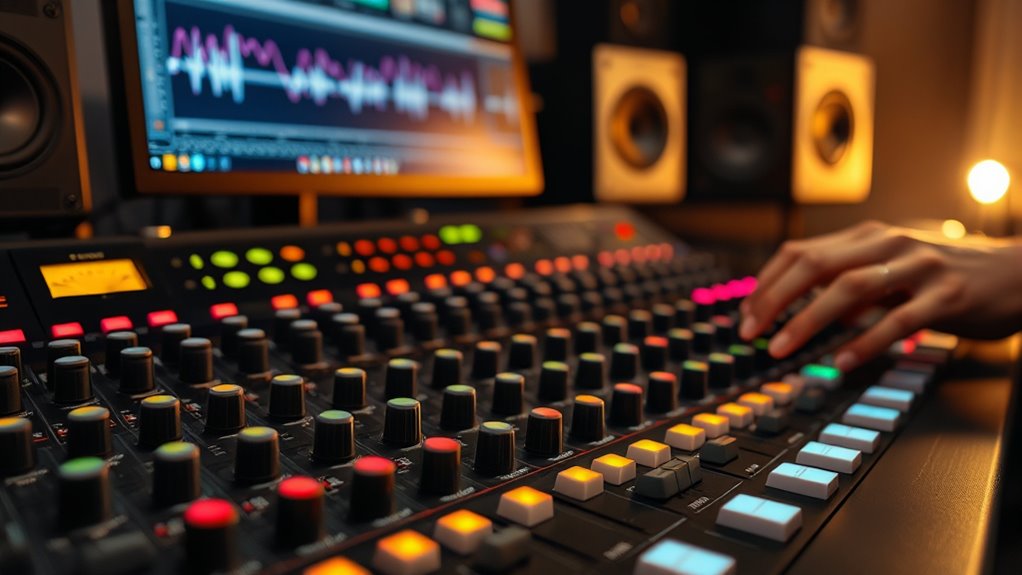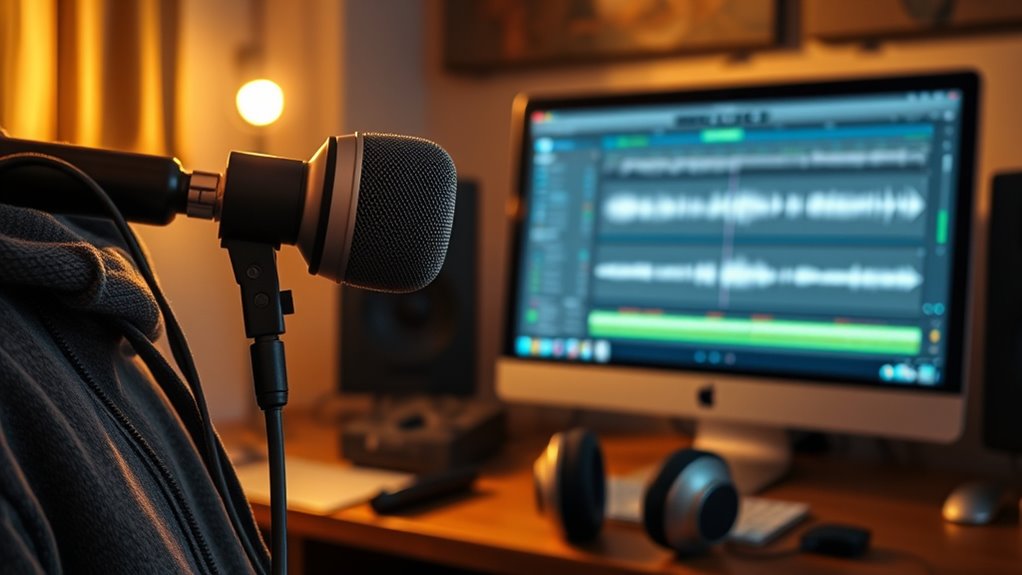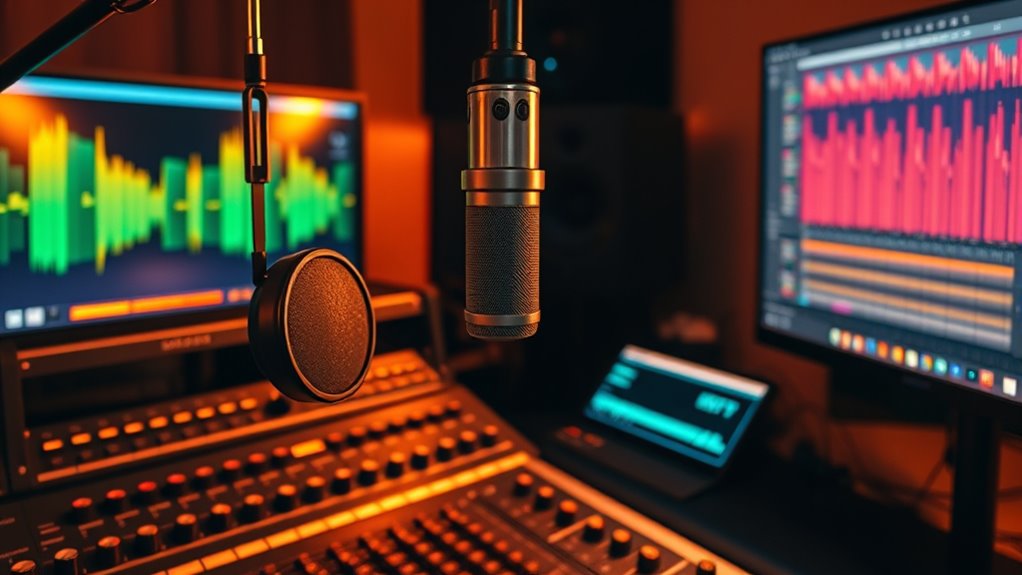To layer vocals like a pop hitmaker without spending on fancy plugins, start by selecting the best takes with steady pitch and emotion. Use panning and volume automation to create natural depth and keep the mix lively. Enhance thickness with basic EQ and gentle compression, emphasizing warmth and fullness. Add natural harmonies and double-tracking for richness, then fine-tune with subtle reverb and careful balancing. Keep experimenting, and you’ll discover how simple techniques can produce a professional, polished vocal sound.
Key Takeaways
- Select the best takes with consistent pitch and emotion, then clean up noise and silences for a polished foundation.
- Use panning and volume automation to create stereo width and dynamic interest in your vocal layers.
- Enhance thickness with basic EQ boosts in low-mid frequencies and gentle compression to control dynamics.
- Record natural harmonies and double-tracks, tuning slightly for authenticity and blending seamlessly.
- Apply subtle reverb and carefully balance levels and panning to achieve a rich, cohesive vocal stack.
Selecting and Preparing Your Vocal Takes

Before you begin layering vocals, it’s essential to select the best takes and prepare them properly. Focus on vocal editing to clean up mistakes, such as background noise or unwanted breaths, guaranteeing each take sounds polished. Listen carefully for performances that capture emotion and consistency, since performance optimization is key to a natural blend. Choose takes where your pitch is solid and the timing aligns well, making it easier to layer later. Trim silences and remove any distracting elements to create a clean foundation. Once you’ve identified your top performances, consider slight adjustments to timing or pitch if needed. Proper preparation ensures your vocal tracks will sit seamlessly in the mix, making the layering process smoother and resulting in a more professional sound. Additionally, paying attention to audio quality can significantly impact the final result.
Creating Depth With Panning and Volume Automation

To create a sense of space and dimension in your vocal mix, you should actively use panning and volume automation. Vocal layering techniques benefit from strategic panning, placing different takes across the stereo field to widen your sound. For example, pan doubles slightly left and right to create a fuller image. Mixing automation strategies help add depth by adjusting volume levels over time, making certain layers stand out or recede as needed. Use automation to subtly bring in backing vocals during key phrases or to soften them during verses. This dynamic control prevents your mix from sounding flat and ensures each vocal layer contributes to a lively, immersive experience. Mastering these techniques makes your vocals sound more polished and engaging without relying on expensive plugins. Understanding stereo field placement can further enhance your mix by creating more natural and spacious vocal layers.
Achieving Thickness Using Basic EQ and Compression

Using basic EQ and compression is essential for adding thickness to your vocals. Start by using EQ to boost low-mid frequencies around 200-500Hz, which enhances body. Apply gentle compression to even out dynamics, making vocals sound fuller. When vocal tuning and noise reduction are in check, your layers will sit better in the mix. Keep in mind:
| Technique | Purpose |
|---|---|
| Low-mid Boost | Adds warmth and thickness |
| Light Compression | Controls dynamics, sustains sound |
| Noise Reduction | Cleans up unwanted sounds |
Additionally, considering Kia Tuning options can help improve your overall sound system, ensuring your music sounds its best inside the vehicle. These steps help create a dense, professional vocal sound without expensive plugins. Basic EQ and compression are your tools for shaping a thick, polished vocal layer that stands out.
Building Natural Harmonies and Double-Tracking

Once you’ve shaped your vocal layers with EQ and compression, adding natural harmonies and double-tracking can considerably enhance the richness and depth of your sound. To achieve this, start by recording your main vocal performance with attention to performance dynamics—sing with emotion and variation. Then, create harmonies by duplicating the main track and vocal tuning them slightly out of tune to sound natural, avoiding robotic effects. Double-tracking involves recording the same part again and blending it subtly with the original, adding thickness without sounding crowded. Pay attention to performance dynamics during each take to maintain expressiveness. Use subtle delays or slight pitch differences to keep harmonies and double-tracks sounding organic, lively, and engaging, elevating your vocal stack to a professional level. Incorporating proper vocal tuning ensures the harmonies blend seamlessly and authentically with the main vocal.
Final Blending and Enhancing Your Vocal Stack

After you’ve layered and enhanced your vocal tracks, the next step is to blend them thoughtfully to create a cohesive and polished sound. Use reverb techniques to add space and depth, but avoid overdo it—subtlety is key. A short plate reverb can glue your vocals together, while a touch of room reverb adds natural ambiance. Focus on vocal layering tips like balancing volume levels and panning to prevent clutter and ensure each part shines. Listen carefully to how the layers interact, making small adjustments where needed. This final blending stage is about refining the overall vibe, ensuring your vocals sit well in the mix without sounding washed out or disconnected. The goal is a warm, unified vocal stack that feels both rich and natural.
Frequently Asked Questions
How Many Vocal Layers Should I Use for a Full Sound?
For a full sound, you should aim for 2-4 vocal layers. Use vocal doubling to thicken the main vocal, while harmony stacking adds richness and depth. Don’t overdo it—too many layers can make the mix cluttered. Focus on blending the layers smoothly, ensuring each one enhances the overall vibe. With just a few well-crafted layers, your vocals will sound full, professional, and engaging without needing expensive plugins.
What Are Simple Ways to Correct Pitch Issues Without Plugins?
Think of pitch issues as little speed bumps on your musical journey. You don’t always need fancy gear—auto-tune alternatives and pitch correction exercises can smooth things out. Try singing with a steady breath, record multiple takes, and listen carefully to spot off notes. Sometimes, manually nudging your pitch during editing works wonders. These simple steps help correct pitch naturally, keeping your vocals authentic without relying solely on plugins.
How Can I Prevent Vocal Muddiness During Layering?
To prevent vocal muddiness during layering, start with EQ layering—cut unnecessary low frequencies in each vocal track to clear muddiness. Use careful frequency masking by assigning different frequency ranges to each layer, ensuring they don’t clash. This way, your vocals stay clean and distinct, even when layered. Keep your EQ simple and precise, and listen closely to how each layer interacts to maintain clarity and punch.
Which Microphone Techniques Best Suit Layering Vocals at Home?
Layering vocals is like weaving a tapestry, and your microphone technique shapes the fabric. You should experiment with close-mic placement to capture warmth and clarity, while maintaining consistent distance to avoid phase issues. Pay attention to room acoustics—use a treated space or soft materials to reduce reflections. Keep your mic at an angle that minimizes plosives, and record multiple takes to blend seamlessly later, ensuring your layers sit perfectly together.
How Do I Ensure My Vocal Layers Stay in Sync Naturally?
To keep your vocal layers in sync naturally, focus on phase alignment and timing consistency. Record each take with a click track or a guide vocal to maintain steady timing. Use your DAW’s phase alignment tools to correct any misalignments, ensuring your layers don’t cancel each other out. Regularly compare your takes, and adjust timing slightly if needed, so your vocals blend smoothly without phase issues or timing gaps.
Conclusion
Think of your vocal stack as a beautiful tapestry you’re weaving; each layer adds richness and depth that makes your song stand out. With simple tools and techniques, you can craft a professional sound without breaking the bank. Trust your ears, experiment freely, and watch your vocals blossom into a full-bodied, mesmerizing performance. Remember, it’s not about fancy plugins—it’s about your creativity shining through every carefully layered note.










